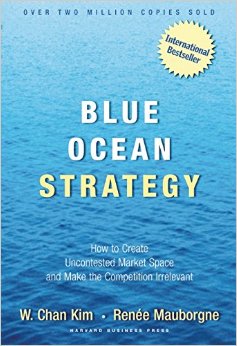Are you reading this article in search for inspiration, for new ideas? You came to the right place!
The good news is that literally anyone can have an idea.
The not-so-good news is that coming up with an idea that really works or creates new value is actually quite difficult. Generating great ideas is even harder. And producing a truly breakthrough idea is harder still.
I know because it’s my job. I help companies innovate around their strategy and their business model. My clients always expect me to come up with something great that will revolutionize their business and create excellent returns. Every time! That’s what I’m paid for.
But now let’s talk about you.
No matter what your job is, you need to come up with good ideas too.
Let’s say that you are writing your resume? You need good ideas! Or you are writing a proposal for a customer? You need good ideas! You are creating a new claim? You need good ideas!
In every aspect of your life, a good idea can be a life-saver, even in your personal sphere with your partner, with your children, with your friends.
Thankfully today we have some proven methodologies for thinking creatively about your company’s business? Many of the organizations I work with have tried methods like Blue Ocean Strategy, The 10 Types of Innovation, the Business Model Canvas, the Value Proposition Canvas, and the Lean Startup Canvas.
But these frameworks, however useful, still require a lot of good ideas if you are going to make a real impact on your business results.
... you will need to come up with lots of good ideas. But where are you going to find them?
Take Blue Ocean Strategy, for example.
It is a great method, I love it, and it works wonderfully. “The first principle of Blue Ocean Strategy” according to W. Chan Kim and Renée Mauborgne in their book Blue Ocean Strategy, “is to reconstruct market boundaries to break from the competition and create Blue Oceans”.
What exactly is a Blue Ocean?
Well, it’s the opposite of a Red Ocean. And a Red Ocean is red from the blood of too many competitors trying to eat each other by going after the same customer’s business.
A Blue Ocean, by contrast, is an uncontested market space. It’s where you open up a whole new opportunity arena that isn’t already filled with competitors.
In other words, it’s about going where your rivals are not.
How do you do that? Blue Ocean Strategy tells you to follow a six path framework, to challenge “six assumptions on which companies hypnotically build their strategies”.
So you have to:
- Look across alternative industries
- Look across strategic groups within industries
- Look across the chain of buyers
- Look across complementary product and service offerings
- Look across functional or emotional appeal (this is one of my favourites)
- Look across time
Going through this six path framework you will need to come up with lots of good ideas. But where are you going to find them?
The method that you choose, whether it’s Blue Ocean Strategy or any of the others, gives you the steps, but the creativity part is up to you. It is you who will have to fill in the dots.
Where do great ideas come from?
I had the same problem. How could I help my customers find new and good ideas?
I have tried many creativity methods. Most did work, some didn’t.
Many of the ones that worked were really hard to learn, master and then teach. I was still in search for a good solution.
Then, one day, an Italian publisher asked me if I wanted to help revise the Italian edition of a book: “The 4 Lenses of Innovation” by Rowan Gibson. The publisher handed me the English edition and I started reading it. And I found what I was looking for!
A method that works, is easy to learn and that can be taught to anyone: The 4 lenses of innovation™.
I fell in love with this methodology, and so will you – for these three reasons:
1. It really works!
Rowan Gibson, the inventor of the 4 Lenses of innovation™, has been using the Lenses with his clients for more than 20 years.
And have a look at a list of some of his customers: Accenture, Apple, Bayer, BASF, British Telecom, Coca-Cola, Credit Suisse, Dow Chemicals, General Electric, Generali Group, Heinz, HP, IBM, KLM, Mars, Microsoft, Nestle, Philips, P&G, Roche, Siemens, Telefonica, Unilever, and Volkswagen.
What a customer list!
You might think: “Well, maybe he is a genius and the 4 Lenses won’t work for me”.
What I did, to know if the lenses worked, was to try for myself. I chose a problem I wanted to solve: I wanted to improve the way people subscribe to my courses.
The objective was to have more attendees subscribe early on and have better conversions. The common way to achieve this is to have 2 fares: a lower one for early birds and a higher one for late subscriptions.
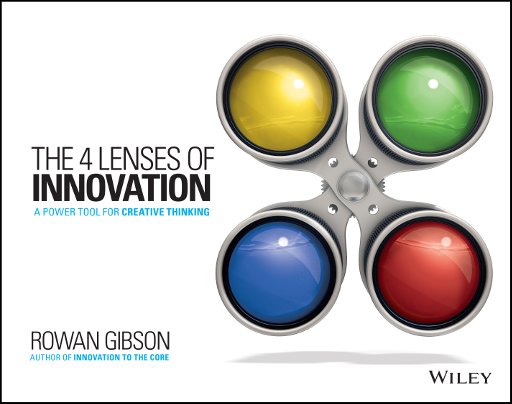
So, working with the 4 lenses, I came up with many ideas and I chose this one: the subscription fee increases every day. I could easily and inexpensively implement it and it works.
If you subscribe to my Business Model Workshop in Milan, today you will pay € 376, tomorrow you will pay € 380, next week € 400 and the day before the event you will pay € 650.
So the 4 lenses did work for me, and now I use them with all my customers and they are very happy. But the 4 Lenses have also worked spectacularly for all the people who attend Rowan Gibson’s workshops around the globe.
Look at Rowan Gibson’s website to find some testimonials: www.rowangibson.com
2. You can learn it very easily
Let me tell you the experiences I had with other creativity techniques. I mainly faced 2 situations or problems.
First, the technique was very complicated. I had problems remembering all the steps and I had to literally draw them to memorize the big picture and be sure not to miss some steps. This also made the overall ideation process long and hard to explain.
The second situation was the exact opposite: the method was so vague that it was hard to understand whether I was doing it right or wrong, if I was taking too much time or not enough. I also had the impression that the ideas were going into the wild and not focusing on specific objectives.
Instead, the 4 Lenses of Innovation™ method is based on 4 very clear pillars. They represent 4 specific ways to look at your problem to come up with new ideas. Those are:
- Challenging Orthodoxies
- Try to look at what is usually taken for granted in your problem domain, then challenge it – blow it up! – and see what happens
- Harnessing Trends
- Look around you at what is happening in the world and try to use the emerging trends to revolutionize the future of your business or your life
- Leveraging Resources
- Take a fresh look at the resources you have (either your own skills and assets or those your organization) and think about how you could use them in new ways to create innovation opportunities
- Understanding Needs
- Try to understand the difficulties and frustrations that people face every day and then see if you can solve them like nobody has before
First advantage: everybody can remember the 4 lenses. It’s easy to keep them live and vivid in your mind, ready for use at any time for any challenge you might face.
Second advantage: they will work for you straight out of the box. You can start using them immediately if you want to, and you will find that they work every time.
Of course you won’t suddenly become a Leonardo da Vinci in creativity, but you are going certainly going to be better than you were before (that’s because they will teach you to think like Leonardo da Vinci, or Steve Jobs, or any of the other great innovation heroes).
And the more you learn about the 4 lenses and practice them, the more you will improve your creativity and ideation skills.
It’s like soccer: all you need is a ball and a pair of feet. Even the shoes are optional. You can start playing soccer right now. You might not be Pelè or Maradona, but you will get better at it if you practice and improve your game.
Third advantage: I have found that the 4 Lenses will improve the way you use any of the other innovation or business growth methods I mentioned earlier, like Blue Ocean Strategy etc. You can apply the Lenses each time that method requires creativity.
3. You can teach it to anyone
Why is this important?
Having a method that you can teach to anyone is important inside an organization because you will want to tap into the brainpower of as many people as possible. More minds at work on the problem, means more solutions you will be able to choose from.
Moreover, you cannot be an expert in everything. When I am helping a client, although I’m an expert on innovation I might not know much about his own market, his industry, his customers. So by engaging as many of my client’s people as people (who do know about these things), we can find new ideas together. And, most importantly, these ideas will be highly relevant and appropriate for my client’s specific situation because the 4 Lenses allow you to focus on solving very particular challenges. There are also a couple of added bonuses: together we are going to find good ideas faster, and buy-in will require a lot less effort because the relevant people have been involved in generating the new ideas in the first place.
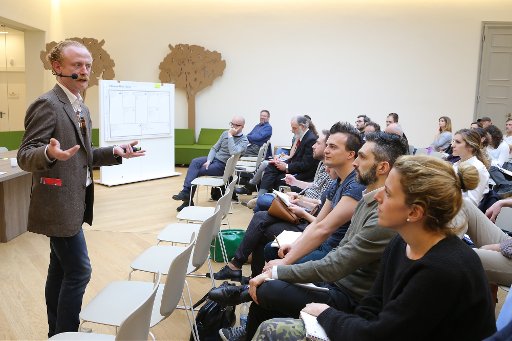
And now what should I do?
Now you know that there is a method out there that can help you come up with good ideas when you need them, that works, and that is easy to learn and to teach: the 4 Lenses of Innovation™.
Start thinking about the kind of ideas you need, both big and small. And then start looking at the problems you would like to solve through the 4 lenses. You will see that your creativity will immediately start to improve. It’s like using a power tool for the mind. Then learn more about the 4 Lenses of Innovation™: buy the book, attend a seminar and start practising creativity in all aspects of your life: work, family, sport, hobbies … and enjoy your improved life!
You will find information about Rowan Gibson’s seminars here http://www.4lenses.it/en/event_list.html
Ugo Mendes Donelli

Helps companies innovate their business strategies to gain competitive advantage and sustainable returns.
He teaches Business Model Innovation at Masters for CUOA Foundation and holds public Workshops on Business Model Innovation, Business Innovation by Design and The 10 Types of Innovation around Italy.
Images
- Love padlocks on the Butchers' Bridge (Ljubljana).jpg - by Petar Milošević
- Blue Ocean Strategy book cover - W. Chan Kim and Renée Mauborgne
- The 4 Lenses of Innovation book cover - Rowan Gibson
- Ugo Mendes Donelli teaching at Nuove Idee Nuove Imprese
Subscribe to the newsletter
You will receive news about new articles, events and workshops about innovation sent by Hugowiz.
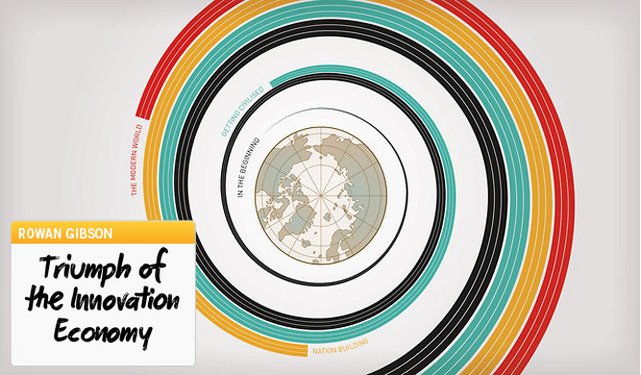
Triumph of the Innovation Economy part 1
By Rowan Gibson, published at Innovation Excellence reedited by Hugowiz
Over the last decade, innovation has clearly moved to center stage in terms of strategic priorities – not just for the world’s business leaders but for economists and savvy politicians, too. In fact, we’ve heard so much about it in recent years that some misguided folks already view innovation as nothing more than a management fad or the latest business buzzword.
With this series of articles, I want to put that notion to rest.
To anyone who believes that innovation is merely the flavor of the month for business journalists, trendy consultants, corporate executives, economic advisors, or government officials, my message is this: take a good look back through history. What you will very quickly conclude is that innovation has been around since we first had the idea to turn rocks into tools, or discovered how to make fire, or invented the wheel, or came up with cuneiform communication on clay writing tablets. Innovation is part of what makes us human.
I would argue that the entire history of the world is a history of creativity, invention, and innovation.
In the many millennia of our existence, there has never been a time when humans were not generating new ideas to make life easier and better for themselves in some way. I invite you to join me on a short journey through time to verify and validate this argument.
A brief history of innovation
Let’s go all the way back to the ancient Natufians – considered to be the world’s earliest culture – who settled in the Levant region of the Eastern Mediterranean (between modern-day Israel and Jordan).
Archeological evidence tells us that they were a very innovative society.
For example, they developed the practice of archery to hunt for gazelles and wild boar; they designed harpoons, fish hooks and nets to catch fish; and they created tailor-made tools and methodologies – such as harvesting sickles, heavy bowl mortars, grinding stones, and storage pits – to help them cultivate and make use of cereals, fruits, and nuts. Indeed, they appear to have been the world’s first culture to practice agriculture. They also built villages with hundreds of round, dry-stone houses, each with a central fireplace. They turned ostrich shells into storage containers. They kept dogs as pets. And they fashioned stones, bones, teeth and shells into jewelry – including beads, bracelets, pendants, earrings, and necklaces. They even carved artistic ornaments out of limestone, like representations of animals and human figurines. In fact, the Natufians produced the world’s oldest known depiction of a couple making love – a carved stone object called “the Ain Sakhri lovers” which can be seen today in the British Museum.
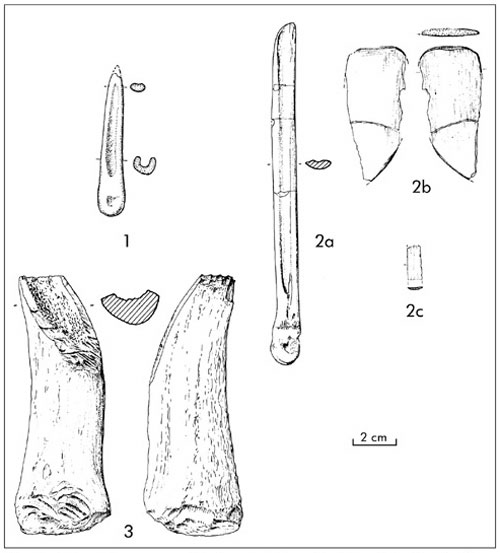
The Ubaidians, who lived later in southern Mesopotamia (now southern Iraq and Kuwait), were pioneers in irrigation agriculture, figuring out how to drain marshes and build extensive networks of canals, which allowed them to plant and grow grains in extremely arid conditions. They also established specialized industries and occupations such as masonry, metalwork, weaving, and leatherwork, and were particularly known for a distinctive style of painted pottery.
These industries gave rise to a booming regional economy and a trading system that reached all the way from the Mediterranean coast to the Persian Gulf.
The creators of civilization
The great Sumerian people that came to flourish in this region built what are held to be the world’s first cities, Uruk and Eridu, with large ziggurat temples and royal palaces as their central structures. They developed new architectural forms such as arches and domes, and constructed buildings using buttresses, recesses, half columns, and clay nails. The success of their irrigated farming and soil replenishment methods led to large surpluses of food which were stored in temple granaries. This attracted more and more people to come and live in the Sumerian cities, which grew in number and size, and the urban population gradually rose to unprecedented levels in the region.
Uruk became the most urbanized city in the world at that time, and at its height is said to have had between 50,000 and 80,000 inhabitants.
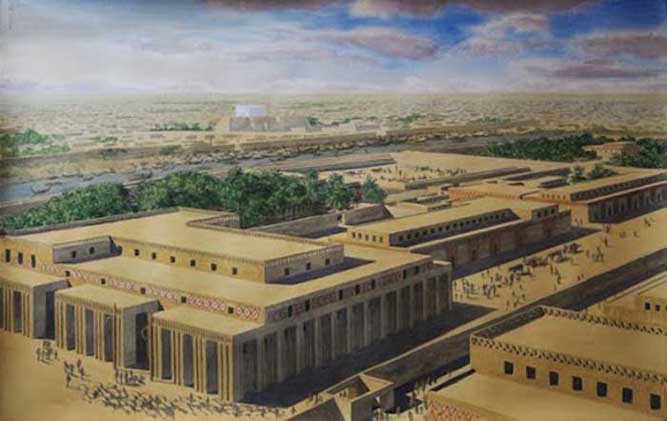
The residents of these city states lived in mud-brick homes with fire-places and chimneys, and some had gardens with trees and other plants. People owned beds, chairs and other furniture with elaborate carvings, and these items were made by skilled craftsmen using saws, drills, hammers, chisels, nails and glue.
The Sumerians invented arithmetic, geometry, algebra, and the abacus, as well as the sexigesimal system of counting (based on the number 60), which led to the 60-second minute and the 60-minute hour.
They also created the concept of a 24-hour day, with two periods (night and day) of 12 hours each. They defined a “work day” of a limited number of hours, with specific start and end times, and allocated “days off” for recreation. They were the first to introduce social stratification, and the concept of property. They made advances in astronomy, mapping stars into constellations, identifying all five planets which are visible to the naked eye, and calculating time in lunar months. They also enjoyed music, perfecting and popularizing the lyre – the stringed instrument of antiquity. It is also believed that the Sumerians invented the first oboe-like instrument, which was apparently used at royal funerals.
Perhaps the most famous contribution the Sumerians made to human progress was their writing system – originally a means of trade communication – which evolved into the common use of cuneiform on clay tablets. The Sumerians eventually produced many thousands of tablets on which they recorded financial accounts, transactions, debt/payment certificates, inventory lists, receipts, letters, laws, history, stories, hymns, prayers, and other texts.

However, the Sumerians innovated in many other breakthrough ways, too. For example, they developed the earliest known potter’s wheel, which was made of stone. This concept then inspired them to create heavy, rounded mill wheels for grinding their cereal crops, and with their next logical step they revolutionized transportation: the Sumerians produced the first wheeled vehicles such as carts and chariots resting on two or four wheels, pulled by oxen or donkeys.
They also designed and built some of the first boats with bitumen waterproofing, and wooden-oared ships for transporting people and cargo on their trade routes. They developed the first codified legal systems, using courts and jails to maintain order in their society. They kept government records to manage city administration. They established the first formal schools. They introduced the world’s first aquarium. They learned to brew beer from barley grains, and figured how to use animal bladders as water skins. Their soldiers were equipped with sandals, boots, swords, daggers, scabbards, axes, knives, lances, arrow quivers and war chariots.
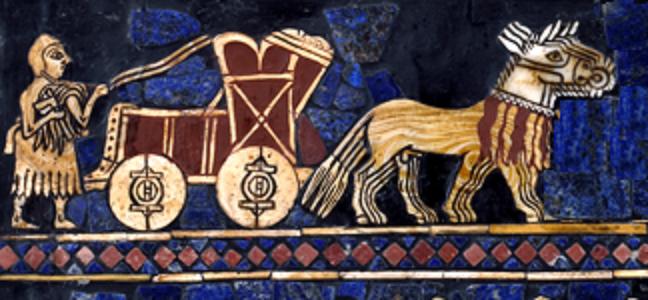
It has been said that the Sumerians were the creators of civilization. The late Samuel Noah Kramer, a world-renowned expert on Sumerian culture, wrote of “the crucial role the Sumerians played in the ascent of civilized man”. The impact of their innovations on the rest of human history – and on our lives today – cannot be overstated. In his book History Begins at Sumer Kramer lists 39 “firsts” from the Sumer region, asserting that “no people has contributed more to the culture of mankind than the Sumerians.”
If the ancient peoples of Mesopotamia – the “Cradle of Civilization” – laid the original foundation for human progress through innovation, how was this foundation used and improved upon by the societies that followed them? Find out in the next article in this series.

Rowan Gibson's new book The Four lenses of Innovation examines the thinking patterns or perspectives that have been catalysts for breakthrough innovation throughout human history, and shows you how to use these perspectives to infuse creativity into your own organization.
Order your copy right here.
Rowan Gibson (rg@rowangibson.com) is recognized as one of the world’s foremost thought leaders on innovation.
He is the internationally bestselling author of 3 major books, an award-winning keynote speaker in 60 countries, and a cofounder of Innovation Excellence.
His new book is The Four lenses of Innovation.
On Twitter he is @RowanGibson.
Subscribe to the newsletter
You will receive news about new articles, events and workshops about innovation sent by Hugowiz.
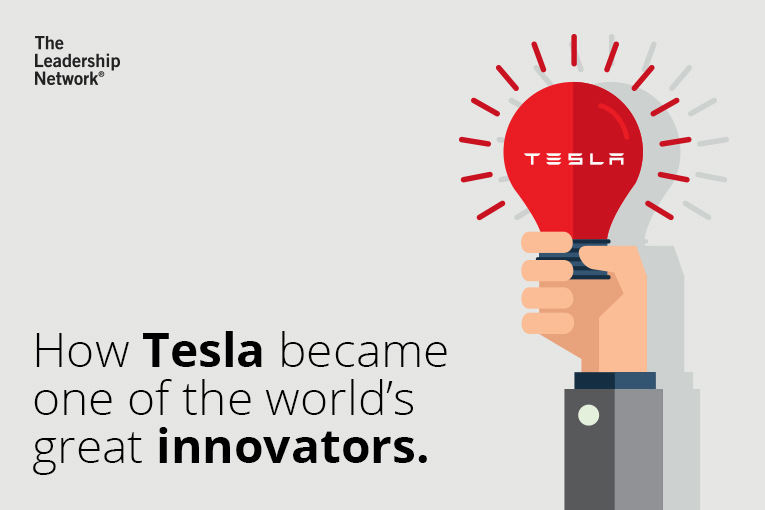
How Tesla became one of the world's greatest innovators.
By Rowan Gibson, published at The Leadership Network reedited by Hugowiz
The Tesla factory in Fremont, California, is a monument to science and progress. Under the roof of this state-of-the-art plant, 160 gleaming silver and red coloured robots, each standing eight-feet high, push the boundaries of technology. In just five days, these mechanical giants and the 3,000 men and women who work alongside them, can fashion a coil of aluminium raw material into a fully functioning Tesla Model S.
Indeed Tesla’s pristine white futuristic facility, which is currently being showcased on YouTube, is quite a sight to behold. I couldn’t fail to be amazed as one metal leviathan stamped a huge laser-cut aluminium panel like a customs official stamping a passport, while another inserted a front seat into a Model S with the manual dexterity of a surgeon.[i] But Fremont, where enormous skylights allow natural sunlight to pour in, is not just a shrine to process efficiency, it is a sanctuary to blue-sky thinking. And at the heart of everything Tesla does is Elon Musk, Tesla Motors’ visionary CEO. For it is the South Africa-born Canadian-American innovator [ii] who is beginning to achieve the unthinkable dream of making sustainable transportation a reality.
In doing so, Musk and Tesla has created a tech-focused super brand that has captured the imagination of the world. Its achievements have not gone unnoticed by global management consultancies too. The Boston Consulting Group, for example, recently ranked Tesla as the world’s third most innovative company.[iii] But what is even more staggering is that BCG only rated Tesla as the 41st most innovative company in 2013. So how has Tesla achieved this magnificent feat and how has it become a world-class innovator?
The 4 Lenses of Innovation
In this, the first of two blogs, I’ll reveal exactly how Tesla has shattered long-established industry paradigms with its game-changing innovative discoveries. But let me begin by first outlining the 4 Lenses of Innovation – a systematic methodology which I specially developed for enterprises to identify and exploit innovation opportunities wherever they find them. They are as follows:
Challenging Orthodoxies
What if the dominant conventions in your field are outdated, unnecessary or just plain wrong?
Harnessing Trends
Where are the market shifts that will, now and in the future, provide the energy you need to make a major leap forward?
Leveraging Resources
How can you arrange existing skills and assets into new combinations that will create radical new growth opportunities?
Understanding Needs
What are the unmet needs and customer frustrations that everyone else has overlooked or ignored?
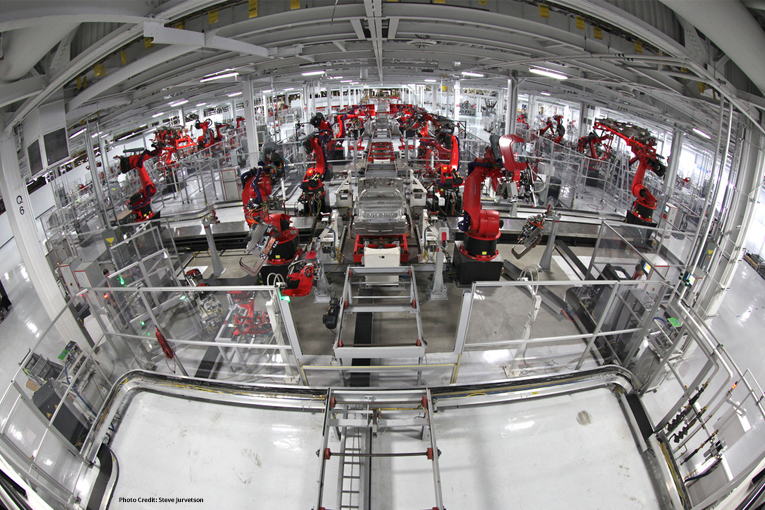
Breaking the innovation mould
To challenge deeply entrenched beliefs is one of the fundamental drivers of innovation. Galileo, Luther and Columbus have their names etched into the history books for doing exactly that.
In one hundred years’ time, Elon Musk, the man behind Tesla’s meteoric rise, who has arguably forged his career on the principle of Challenging Orthodoxies, might yet join this vaunted pantheon of innovators. Like them, Musk was courageous enough to question what we had all accepted as gospel and it is this contrarian spirit that makes him truly stand out.
He saw a niche in the market for a “technology company making electric cars”[x] and ever since founding Tesla in 2003,[xi] in San Carlos, California he has proved that the dominant conventions dictated by the automotive establishment could be both challenged and successfully overturned.
Musk was brave enough to believe that there was a viable and more sustainable alternative to the traditional petrol-powered vehicle, and he stubbornly refused to listen to the majority of investors and Original Equipment Manufacturers (OEMs) who did not think such a revolution was possible.
Understanding and acting on new trends
Musk is one of the world’s great innovators. And like every successful innovator he is someone who is very good at Harnessing Trends, which is the Second Lens of Innovation. By this, I mean that Musk was one of the first to truly comprehend how emerging developments – in particular the rise of environmental awareness and the falling price of batteries – could fundamentally alter the shifting automotive landscape.
Take the financial crisis that struck the world in 2008, for example. For the majority of the automotive industry it was a dreadful time. In the USA Chrysler and General Motors had to be bailed out by the US government, while the big three’s (Ford, Chrysler and GM) U.S. market share declined from 70 per cent in 1998 to just 53 per cent a decade later.[xii]
However, for Musk the financial downturn represented an opportunity to make his mark. With most of the larger players hamstrung by the financial crisis, innovation investment fell by nearly 30 per cent.
But for Musk, this was the key time to ratchet up Tesla’s innovation spending. And it was the work carried out in the aftermath of the global downturn that provided Tesla with the confidence and impetus to move forward. Indeed if the electric car does ever replace the conventional fuel powered vehicle, then the history books might reveal that this was the critical time when the tech giants stole a march on their automotive rivals.
Leveraging resources
Perhaps Musk’s greatest skill is not his inventiveness (In addition to Tesla, he co-founded the online payment system, PayPal. He also runs three other tech companies in space transport, energy services and artificial intelligence research [xiv]) but more the fact that he has combined, stretched and leveraged the core competencies and strategic assets of his various companies into one integrated, overarching strategy.
All are inter-linked and share their technology platforms with each other. For example, if you were to closely examine the body and chassis of the Tesla’s Model S, you’d discover that it is mostly manufactured from aluminium. Not only did Tesla realise that aluminium was a fraction of the weight of steel, it was also much stronger. But how did Tesla know this? By cross-fertilising its assets from two different industries, Tesla’s engineers visited Musk’s SpaceX venture and were then able to adapt the aluminium body from its Space X falcon rocket for its cars.[xv]
Musk is also an advocate of prioritising knowledge over experience. He understands the unmet and unarticulated needs of his customers and knows exactly what it will take to delight them, which is the Fourth Lens of Innovation.
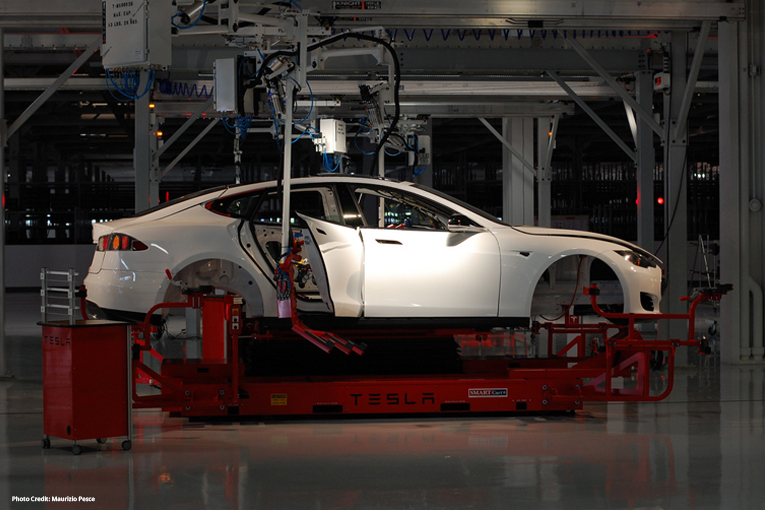
Understanding Needs
It would have been easy for Musk to recruit senior executives from large automakers. But while it might have looked good for Tesla to hire top executives from an established OEM or a Tier-1 giant, Musk knew it would be missing the point. He recognised that in a fast changing world, where conditions are far from certain, it is much more important is to recruit thought-leaders who are capable of solving complex issues through innovative and ground breaking ideas. [xvi]
For example, Tesla is not looking to the automotive heartland of Detroit to recruit the 1,600 employees it needs to cement its position as a market leader in sustainable transportation. Employees from established automotives or Tier-1s need not apply. Instead, Tesla will focus its recruitment efforts on Silicon Valley. But why hire Silicon Valley’s finest, especially when many of them have never even seen an automotive assembly line? [xvii]
No matter. For Musk and his team that is not important. They were quick to realise that the automotive landscape is changing rapidly. The future is increasingly about electric mobility and about software-based vehicles that resemble “iPads on wheels”. It’s about pushing the boundaries of current technologies – i.e battery cell development and the e-Powertrain. And it’s also about pioneering disruptive technologies such as self-driving vehicles.
This requires a level of expertise only found in global technology hubs like Silicon Valley, Bangalore (India) and Zhongguancun in Beijing, China. And it is these bright young computer programmers that Musk has earmarked to be the engineers of tomorrow.
What’s more, he has succeeded in embedding innovation as a deep, enterprise-wide capability inside Tesla. Take Tesla’s bonus and promotion structure, for instance. It is heavily oriented towards ingenuity and inventiveness, whereas at a traditional OEM for instance, bonuses are dependent on how much profit a particular employee generates for the company. But not at Tesla. Instead an engineer is rewarded for doing something that makes the company better or improves a particular product or solves a particular problem for customers.
Work rate
American inventor, Thomas Edison, famously defined Genius as one percent inspiration and 99 per cent perspiration. Whatever you believe, one thing is certain. Given that invention is now recognised as a key driver of long-term business performance, it is nonsensical for enterprises to believe that innovation somehow happens by chance. It doesn’t. You have work to at it.
Elon Musk knows this better than most. He realised early on that innovation cannot be a comfortable process. Tesla engineers have compared it to “jumping out of an airplane and designing the parachute on the way down.” In a recent biography, for example, Musk recounts how he contracted malaria after holidaying in Brazil and South Africa. What is particularly revealing is that malaria, a life threatening condition which claimed 438,000 [xviii] lives last year, did not seem to concern Musk. Instead, he saw it as a petty annoyance that had robbed him of valuable work time. “That’s my lesson for taking a vacation: vacation will kill you,” he told the biographer.

Speed of Innovation
It’s one thing to generate ground-breaking ideas, and another to put them into practice. But there is one additional variable these days that many innovators fail to take into account. In today’s fast changing economies, markets are moving at breakneck speed and so your innovation offering must do so too.
According to a recent BCG report, 42 per cent of fast innovators are strong innovators.
Tesla, for example, was quick to grasp the importance of speed. Tesla might not be as heavily resourced as some of its OEM counterparts but it manufactures batteries on its US site (Fremont) and because speed to market is vitally important, it prefers to produce the majority of components in its California plant too, rather than rely on the Tier-1 and Tier-2 supply chain.
But the fast-paced ingenuity that Tesla practices is linked directly to the disruptive innovation model that is has adopted. The BCG survey for example also highlights that fast innovators are more disruptive.
The disruptive model that Tesla employs is a result of Musk and his team being bold enough to Challenge Orthodoxies and empathic enough to understand and address the unmet needs of Tesla’s customers.
On the face of it, the paradigm just shouldn’t work. Even Musk himself had his doubts at the beginning. For Tesla’s innovative blueprint does exactly the opposite to traditional financial models. Most retailers for instance pitch their goods at the masses first, and only when they have built up a loyal following do they consider adapting their product for the high-end buyer.
Tesla on the other hand, has deliberately targeted the ultra-premium car consumers from the very beginning, and only when it has made inroads within this luxury car segment will it make a vehicle for the masses.
Tesla hopes to realise this ambition in 2017, when it plans to release its Model 3, which will be sold for USD$35,000 (UK£ 23,000). [xxi]
Innovation as the unique Selling Point
Lastly, in embodying the 4 Lenses of Innovation, Elon Musk has made invention his USP.
This means that Tesla doesn’t have to play by the same rules as established OEMs. Instead, it can focus all its efforts on reacting to innovative market opportunities such as developing Autopilot, its autonomous car IT system.
As it is not yet turning a profit, it’s not bound by the pressure of having to produce a set number of vehicles each year. Nor is it shackled by the pressure to drive profit. In 2014 for instance Tesla cut its sales forecast by 10% after assembly line automation issues stalled production.[xxii]
This would concern most CEOs, but not Musk. He has seen the bigger picture and understands the unmet needs that everyone else in the automotive space is ignoring.
Tesla’s future is firmly rooted in producing the world’s best car, and installing the correct infrastructure to support this most ambitious of builds.
Over to you, Elon…
Subscribe to the newsletter
You will receive news about new articles, events and workshops about innovation sent by Hugowiz.
Subscribe to the newsletter
You will receive news about new articles, events and workshops about innovation sent by Hugowiz.

